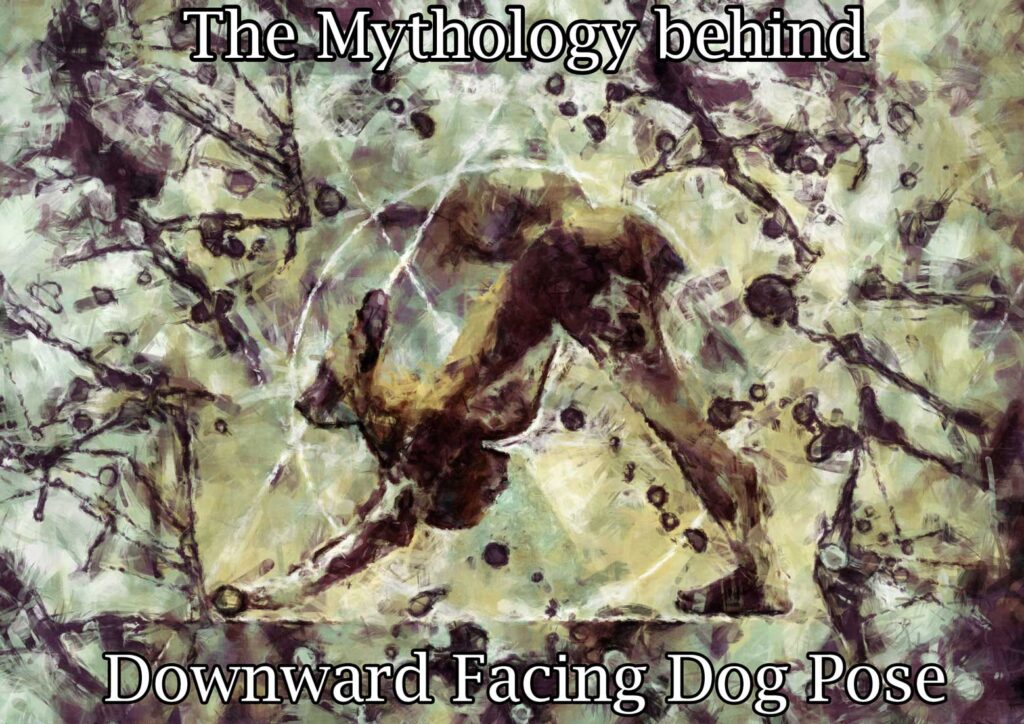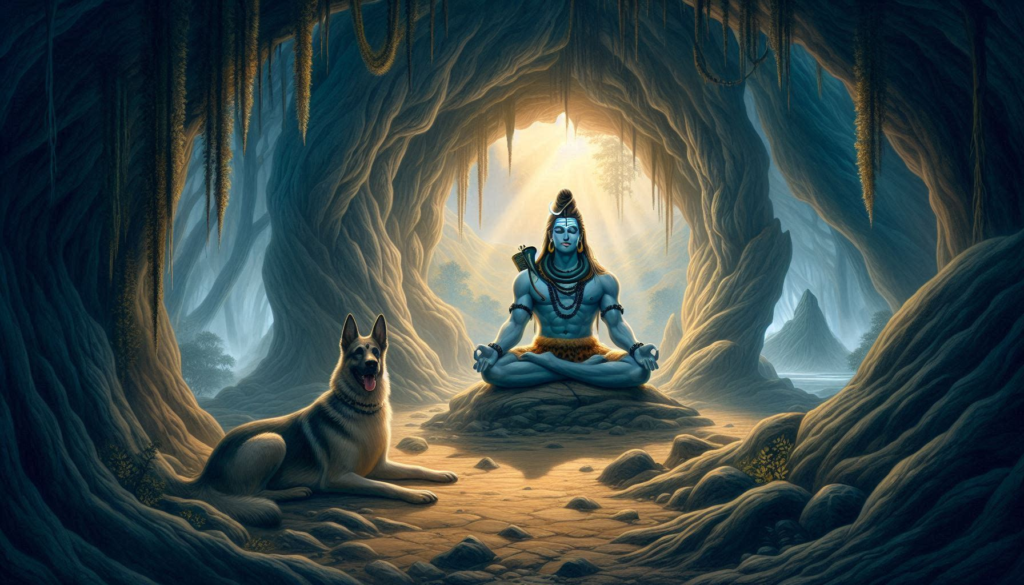
Downward Facing Dog, or Adho Mukha Svanasana, is a foundational yoga posture with deep roots in Hindu mythology, offering both physical and spiritual benefits. This posture, commonly practiced in modern yoga, is revered for its ability to increase flexibility, relieve stress, and balance energy within the body.
In Hindu mythology, the dog symbolizes loyalty, courage, and devotion, often appearing as the faithful companion of the god Shiva. Known as the lord of meditation and yoga, Shiva is often depicted with a dog guarding the entrance to his cave—a sanctuary of deep meditation. This cave serves as a metaphor for the unconscious mind, a realm of profound stillness and introspection. Similarly, yoga practitioners use poses like Downward Facing Dog to embark on an inward journey, exploring and connecting with the deeper layers of the self

The association between this posture and the dog extends beyond symbolism. It is said that the Downward Facing Dog posture originated from observing a dog stretching after sleep, a natural motion that inspired early practitioners to incorporate it into yoga practice. Initially known as the “dog stretch,” this posture served as a preparatory movement for meditation, helping to warm up the body and focus the mind.
Cerbura and Cerberus: Guardians of the Threshold
The link between the posture and mythology also resonates with the stories of Cerbura and Cerberus who serve as guardians of critical thresholds. Cerberus, the famed multi-headed dog of Greek mythology, stands watch at the gates of the underworld, ensuring that souls cannot escape and that the living dare not trespass. The underworld, in many traditions, symbolizes the unconscious mind—the place where hidden fears, suppressed desires, and forgotten truths reside.
Similarly, Cerbura, the three-headed dog of the Krishna legend, guards the pathways between the realms of existence: Patala (the underworld), the mortal plane, and the divine realms. Each of Cerbura’s heads represents a fundamental aspect of spiritual progression—karma, dharma, and moksha—acting as a sentinel over the seeker’s journey toward self-realization.
In this way, both Cerbura and Cerberus embody the role of the threshold guardian, challenging those who wish to delve into deeper truths. Downward-facing dog reflects this mythological function: the pose creates a physical and mental space where practitioners can confront their own inner thresholds, balancing the material and spiritual, conscious and unconscious.

In Greek mythology, heroes such as Orpheus and Heracles managed to pass Cerberus not through brute force alone but through music, wit, or divine favor—tools of the mind and spirit.
Downward-facing dog, similarly, is not simply about physical effort; it is a gateway posture, requiring balance between strength, surrender, and focus. It asks the practitioner to confront their inner guardian—whether that guardian represents fear, resistance, or ego—and move through it to deeper understanding.
The mythological dogs remind us that the path to self-realization is not linear or easy. It requires meeting our inner challenges head-on, much like Krishna approaching Cerbura or Orpheus facing Cerberus. Downward-facing dog is both a refuge and a challenge, a place to pause and reflect as we prepare to cross the thresholds within ourselves.
In the posture itself, the body is inverted, with hands and feet grounded and hips lifted toward the sky. This inversion not only strengthens the body but also shifts the flow of energy, allowing the practitioner to balance their chakras and access a state of inner harmony.
Downward Facing Dog is more than a physical exercise; it is a bridge between ancient mythology and modern practice, symbolizing loyalty, courage, and the journey inward. Whether connecting with the sacredness of Shiva’s meditation cave or contemplating the depths of the unconscious mind, this posture continues to hold immense significance in yoga, guiding practitioners toward physical well-being and spiritual growth.
Sarama: The Fleet-Footed Guide of Intuition
Sarama, the “Hound of Heaven,” is another divine canine whose story is deeply entwined with intuition and truth. As the messenger of Indra, the king of the gods, and the mother of the Sarameyas, two dogs who serve Yama, the god of death, Sarama bridges the worlds of life, death, and divine insight. Her name, meaning “the fleet one,” reflects her ability to follow the path of truth with unwavering focus.
Sarama’s greatest feat was finding the sacred cows stolen from the Angirasas, the fire priests, a task no one else could accomplish. Guided by her intuition and divine insight, she followed the path of truth and uncovered what was hidden.
In downward-facing dog, we can channel Sarama’s qualities of intuition and focus. This pose invites practitioners to trust their inner guide—both in their physical alignment and in the breath that flows like a hound tracking its path. Sarama’s ability to uncover truth reminds us that this pose, though seemingly simple, can reveal hidden aspects of ourselves, fostering self-awareness and connection to the divine.
Lord Dattatreya, a personification of Brahma, Vishnu and Siva is always accompanied by four dogs who symbolise the four Vedas
Dogs have long been revered as spiritual and symbolic creatures across cultures, and their presence in the ancient Vedas beautifully illustrates their multifaceted nature. Just as dogs come in many shapes and forms, the four Vedas—Rigveda, Yajurveda, Samaveda, and Atharvaveda—express unique qualities that can inspire your focus and flow in the downward-facing dog pose (Adho Mukha Svanasana).
- Rigveda and the Pariah Dog:(Indian street dog) Representing simplicity and humility, the Pariah dog embodies the grounded essence of Rigvedic teachings. In downward-facing dog, channel this humility by rooting your hands and feet firmly into the earth, fostering stability and a connection to your foundation.
- Yajurveda and the Sighthound: The swift and agile Sighthound mirrors the precision required in Vedic rituals. When practicing downward-facing dog, let your movements flow with purpose, engaging in mindful transitions as you refine your alignment and bring energy into the pose.
- Samaveda and the Spitz: Known for its musical chants, the Samaveda reflects harmony and rhythm. Like the Spitz with its high-pitched bark, focus on the breath as a melody, using the inhale and exhale to create a seamless flow between stillness and movement in the pose.
- Atharvaveda and the Mastiff: The protective Mastiff symbolizes strength and power, much like the Atharvaveda’s spells for protection. In downward-facing dog, embody this strength by activating your core, elongating your spine, and creating a firm yet flexible base that supports your practice.
By understanding the qualities associated with these sacred texts and their symbolic dogs, you can approach downward-facing dog with fresh inspiration. Whether seeking simplicity, agility, harmony, or strength, this pose offers endless opportunities to explore your focus and flow—just as the Vedas guide seekers through the vast spectrum of human experience.
